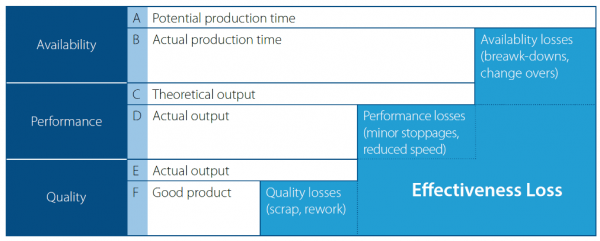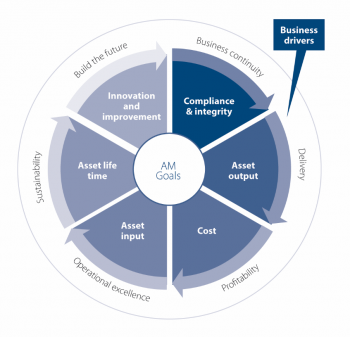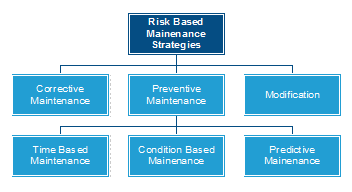The importance of policy and strategy for Asset Management
Maintenance is one of the pillars of Asset Management and plays an important role in the achievement of a successful value in use. Over the years, many programs have been developed with the improvement of maintenance in mind. For example, Total Productive Maintenance (TPM), Reliability-Centered Maintenance (RCM), Business-Centered Maintenance (BCM) and Life Cycle Costing (LCC) (Waeyenbergh & Pintelon, 2002). Most organizations see one or more of these programs as the solution to the ‘problems’ they have in relation to Asset Management (AM). However, they forget the most important factor: the policy and strategy of the organization, from which the asset management strategy should be derived.
At Stork, we distinguish six Asset Management objectives, as shown in Figure 1:
|
Figure 1: Asset Management Objectives (Source; Stork) |
- Asset Compliancy & Integrity: compliance with health, safety and environmental requirements and compliance with (internal and external) legislation and regulations;
- Asset Output: generating the correct number of ‘compliant’ and ‘high-quality’ products at the right time;
- Asset Input: controlling 'input' losses, such as energy, raw materials and/or labor/overheads;
- Costs: the achievement of corporate objectives at optimal cost in the short and long term;
- Asset Lifetime: the achievement of the asset life required;
- Innovation & Improvement: continuous improvement of assets and Asset Management performance.
The policy and strategy of the organization and the Asset Management objectives above should be the starting point when formulating the AM strategy and the corresponding activities/concepts for operation, engineering and maintenance. However, many asset owners struggle to achieve these objectives and come up with possible solutions to 'problems' that do not actually exist. The example below will be used to explain the importance of the policy and strategy of the organization and the corresponding AM objectives for AM strategy.
The importance of the policy and strategy of the organization
Example 1: an Asset Manager is evaluating the performance of the assets of the production company by which he/she is employed. The manager concludes that too much corrective maintenance is being done, because of which performance by the assets is disappointing. The corresponding throughput (Asset Output) is inadequate, as well. The following observation is made as a result: "We are doing too much corrective maintenance and must do more preventive maintenance. To define this maintenance, we need to carry out an RCM study." However, the installation has an Overall Equipment Effectiveness (OEE) of 60%, whereas demand has a required OEE of approximately 40% (due to sales restrictions). For the sake of clarity: OEE quantifies how well a production unit is performing in comparison with the designed capacity, during the periods in which the operation period planned for the production unit (see Figure 2).

Figure 2: Overall Equipment Effectiveness (Bron: Chan et al. (2005))
Example 2: now imagine the same situation with an average OEE of 60% on the one hand and a required OEE of 80% on the other. Here too, the manager concludes as follows: "We are doing too much corrective maintenance and must do more preventive maintenance. To define this maintenance, we need to carry out an RCM study."
Before you carrying on reading: What are your views on these two examples and what is your opinion about the observation of the asset manager?
It can be concluded from the examples above that, although availability is the same in both and something is experienced as a problem in both, as well, "too much corrective maintenance" may or may not actually be a problem given the availability required. Even though corrective maintenance is experienced as being "too much" in the first situation, availability is sufficient to meet demand. With this in mind, an increase in availability/output should not form part of the policy and/or strategy of the organization. In this situation, an RCM study will be an unnecessary waste of resources. However, this does not mean that an RCM study cannot be carried out to achieve other objectives. For example, cost reductions and/or the improvement of the asset life time. For the second example, an RCM study could be of added value, helping to improve reliability and availability.
Based on the two examples above, it is clear that the environment in which the organisation operates influences its policy and strategy and, as such, affects AM strategy and the decision on whether or not to implement a program to improve the performance of assets. But how do you define the "right" policy and strategy? The next section provides an insight into policy and strategy development. Attention will then turn briefly to the various maintenance concepts possible.
Policy and strategy development
When developing and determining policy and strategy, the corporate objectives of the owner (the asset owner) must be taken as the starting point. The type of owner and its objectives will determine the opportunities and obligations to be met by both. The policy and strategy must determine what the organization plans to achieve from its activities and when. An important requirement for effective policy and strategy is the inclusion of objectives that are specific, measurable, acceptable, realistic and time-bound (SMART). A (general) traditional approach:
- Start by identifying the mission, vision and/or values;
- Carry out a situational analysis based on external and internal assessments;
- Establish broad objectives in accordance with the mission and results of the assessments;
- Identify strategies for the achievement of these objectives;
- Develop specific action plans to achieve each of the objectives.
It will now be clear that emphasis only shifts to the organization and achievement of the predetermined objectives and strategies from the fifth step onwards, during which specific action plans are developed. Where the approach outlined above is concerned, it can again be concluded that it is not wise to develop specific actions that are not geared towards the strategy established. However, what if they are in line with strategy? If so, two types of maintenance will need to be carried out: maintenance required by law and risk-based maintenance. Both are described below.
Maintenance concepts
Maintenance required by law
Certain types of assets are subject to rules and/or regulations imposed by government and the environment in which a company operates. There are also assets that are dangerous for people or the environment. For these assets, the government requires that a series of (preventive) maintenance tasks, tests and inspections are carried out, regardless of the wishes of the user. There are even situations where these tasks may only be carried out by authorized companies. These tasks must be included in the maintenance plan, regardless of which model you decide to use.
Risk-Based maintenance
Risk-based maintenance focuses on the performance of analyses, measurements and periodic test activities with the object of standardizing the maintenance carried out. Examples include Hazard and Operability (HAZOP), Layer of Protection Analysis (LOPA), Safety Integrity Level (SIL) and Reliability Centered Maintenance (RCM) (incl. FMECA) studies. The information collected will be considered in the context of the environment, operation and process conditions of the assets in the system. The object is to carry out the risk assessment based on current conditions and to define appropriate maintenance plans. The most important consideration here is to decide whether it is more effective to postpone maintenance and carry out corrective maintenance, to carry out (effective) preventive maintenance or make a modification that reduces the level of risk applicable.
The most important characteristic of corrective maintenance is that actions are only carried out if a piece of equipment has developed a fault. In other words, no interventions are carried out until a fault has occurred. Once this is the case, corrective action can be taken immediately (unplanned corrective) or can be scheduled for a later date (planned corrective).
|
Preventive maintenance is a proactive maintenance strategy that aims to increase the reliability of equipment and/or to guarantee a certain degree of reliability. The aim of preventive maintenance is to ensure that faults are avoided or detected at an early stage or that hidden faults are discovered. As shown in Figure 3, preventive maintenance can be broken down into time-based maintenance (calendar days or operating hours), condition-based maintenance (performance monitoring) and predictive maintenance (the analysis and prediction of parameters).
Finally, modifications must be carried out if preventive maintenance is not able to reduce risk to an acceptable level. In this situation, the installation must be changed to increase system reliability in advance.
Conclusion
All in all, maintenance makes an important contribution to the creation of successful value in use. In this connection, it has been suggested that AM strategy must be aligned to the policy and strategy of the organization if the value in use is to be improved. It is also important to know which maintenance is to be carried out by law, in order to achieve compliance, and which risk-based maintenance could have added value.
References
Waeyenbergh, G., & Pintelon, L. (2002). A framework for maintenance concept development. International Journal of Production Economics, 77 (April 2000), 299–313.
Chan, F. T. S., Lau, H. C. W., Ip, R. W. L., Chan, H. K., & Kong, S. (2005). Implementation of total productive maintenance: A case study. International Journal of Production Economics, 95(1), 71–94.
Stork. Stork Asset Management Technology

